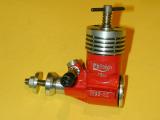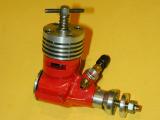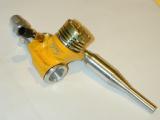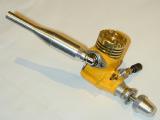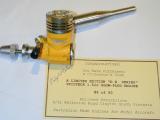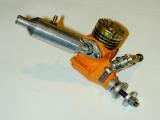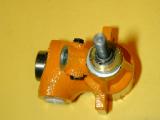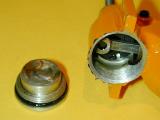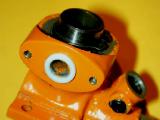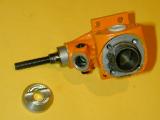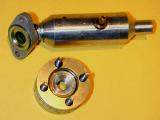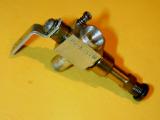| Name | Philtech | Designer | Philip G Morten |
| Type | Two stroke, glow and "diesel" | Capacity | 1.49 cc |
| Production run | relatively small | Country of Origin | Australia |
| Photo by | Ron C | Year of manufacture | circa 1990 |
Notes:
Philtech is an Australian engineering company owned and managed by Phil Morten. As far as I'm aware, their main line of business is in the medical arena, but as Phil suffers from a love of small model engines, he has from time to time produced limited production runs of engines to his own design. The single cylinder series described here were produced during the 1990's and are no longer available. His current model offering is a rather clever, "V" configuration, multi-cylinder glow engine, of a "modular" design, but that's a story for another day.
The engine shown here, and at the head of the page, is the 1.5cc diesel produced as a "Collector's Series". It is quoted on the manafacturers' instruction leaflette as having a bore of 12mm, and a stroke of 12.5mm, which my calculator says gives it a capacity of 1.41cc. From the number, we can guess that this was engine number 52 , build in December 1993. But as the "5" looks rather like an "S", it could mean "Series 2" (as it is called in the leaflette) and not be a serial number at all! All the Philtech range would be classified as "sport engines", which is to say, not outstandingly powerful for their weight, but robust and well behaved. Both diesel and glow variants share the same basic construction which is described in some detail below. I rather like the looks of this engine (owned by Mr Van Richards-Smith), except for the rather pedestrian "star" washer under the spray bar nut, but then I've never been rightfully accused of having a discriminating taste...
The glow variant shown here was another limited, numbered, "collectors'" series engine sharing many components with the diesel variant (including that sore-thumb-like star washer). It has been adapted to glow-plug operation and fitted with a tuned pipe. Note that while the "Philtech" brand is engraved on the side, unlike the diesel it carries no serial number engraving on the left lug.
The pipe attachment is a clever innovation. It uses a die cast clamp fitting (of unknown origin, but almost certainly not Philtech) acting against a flange, pressing this against a PTFE gasket on the crankcase. This allows the pipe to be angled as required by the user. Angling into the propeller arc would seem to provide no concrete benifit and would be, at any rate, a short-term arrangement.
These photos show the owners' certificate supplied with the glow engine, and the boxes for the glow and diesel versions. My conclusion is that the "tuned pipe" glow appeared on the market after the diesel as the box has a sticker applied over the "diesel" word and I've been told that the price of obtaining printed packaging like this for small production runs can exceed some of the major parts of the engine! Note the (Oz) price stickers on the boxes. Were they repriced down to sell, or up for inflation? Dunno...
Here we see another of Van's Philtechs--this time an R/C glow. Van has the box this one came in too, but as it also contained a complete R/C trainer kit, showing it would be pointless. Phil Morton informs me that about 200 engines were made for inclusion with these kits. The kit manufacturer obviously hit the "cost of packaging" problem too as I've since seen a trainer kit with a sticker over the "includes Philtech engine" text saying "includes electric motor". How's that for a sign of the times? You've probably noticed the variation in colors and are making incorrect assumptions regarding a color coding scheme. Van made the same error and for a time, was trying to collect all the colors ("Kids! Be the first on your block to collect ALL the colors..."). Contrary to popular opinion, there is a plan behind the enamel sprayed cases, as well as a need to tart-up the rather pedestrian sand castings. According to Phil himself, it goes like this:
| Series 1 Diesel | Silver |
| Series 1 Diesel Limited Edition | Black |
| Series 2 Diesel | Metalic Blue |
| Series 2 Sports (no Muffler) | Light Red |
| Series 3 | Dark Red |
| Series 1 Glow | Yellow |
| Series 2 Glow | Orange |
Phis added that there was probably some odd combination that slipped out as well, and that there was yet another range of colors used for Series 2 diesels made exclusively for export to the USA only.
While Van's not looking, let's pull the R/C glow apart, take some photos, and inspect the unusual features of this design. First there's the case and the bane of the homebuilder's existance: mounting a knobbly sand casting and boring the crankshaft hole, necessarily from the rear, hoping that it emerges in the middle of the journal protrusion. Generally it doesn't, and hasn't here either. This is going to look rather obvious when the prop drive washer is added, so one "fix" is to mount the case on a mandrel and turn down the front of the casting concentric with the shaft bore. But no matter what, you are going to end up with a step someplace. Here, it is just ahead of the venturi. The brass thing is not a bush, but a washer that also takes up some end-play in the shaft (quite a lot, actually). Also evident in this shot are the sins that the paint is attempting to hide (kinda like a close-up of the makeup on the face of a bargin basement working-girl, yeetch!!) and the obvious fact that the paint and high-nitro fuel are not the best of friends.
Moving arount to the tail-end of the beast, we see the conventional screw-in backplate. This is fitted with an "O" ring as a gasket--a little unusual, but no totally unique. Inside the case, the aluminium rod is visible, as is the rather nodding concession to balancing via a scalloped crescent turned on the shaft. The black finish of the shaft suggests it has been hardened, and hence ground. Close examination of the front of the shaft in the previous shot shows that the threaded portion is a screw-in stud. This is a feature I highly approve of. It not only simplifies and speeds manufacture, but also greatly improves crash-worthiness. Bent studs are easily and cheaply replaced, and since virtually all the crank shaft is supported by the journal bush, it is far less susceptable to damage. The slot eviden in the side of the crankshaft web is a common way of "keying" the unfinished shaft to the fixture that will hold it while the crankpin is formed so that it can be dropped into another fixture and keyed to drill the inlet hole in relation to the crankpin. Smart idea and well worthwhile if you are making more than one shaft to a specific design.
Here we see the PTFE washer that seals the muffler (not a tuned pipe in this case) to the case. Also visible is the generous proportions of the case casting around the exhaust. But if you look closely, you'll see one of the most unusual and innovative features of the design: the cylinder liner flange is actually a circlip seated in a groove on the straight, cylindrical liner sleeve. I don't know if what the material used is, but a good choice would be 4140 chrome-molly, aircraft grade tubing. This is readily available in many different outside diameters and wall thichnesses. It machines easily and can be hardned and honed to make an excellent liner, as Phil has done. The sharp edge of the circlip groove does provide a point of weakness, but as the head will be placing the upper part of the liner in compression rather than shear, it will pose no real risk. So, cheap and easy, although Phil now says it was not one of their greatest ideas. The liner may have been heat shrunk into the case as I could not budge it and did not feel like heating the case to try (this would have to be done in boiling water as the paint is just not going to be gas-axe friendly).
The top view shows the circlip (and gasket) described previously. Of more interest here is the innovative (read: cheap and easy, but effective) way the prop drive washer attaches to the crankshaft. Flats have been machined (or ground) either side of the part of the shaft protruding from the case journal. the rear of the drive washer has been channeled with a slot-drill to engage the flats. Not all that attractive, but certainly innovative--in fact, I've never seen anything like this anywhere before! Just evident on the rear wall of the liner is one of the two transfer ports. These are cut into the tube walls at an angle facing towards the rear of the cylinder, making this a classic Schnurle port design--the many and various additional ports we associate with that term today (so-called "boost-ports") being a relatively recent addition to the original concept. The poston is the expected flat-top design and appears to be machined from cast-iron.
The cylinder head and cooling fins are a single unit, secured with four machine screws. The combustion chamber is hemishperical. Judging by the machining marks, it was most likely cut with a ball-nose slot-drill. While a close-fitting copper gasket has been used under the circlip to provide a positive case-to-flange seal, the only seal of liner to head is the edge of the tube against the aluminium. The head is yellow-anodized (ugly, I think) and shows some evidence of pressure leakage from the limited running this engine has had. In the rear of this photo is the sausage muffler with captive clamping ring and a screw-in pressure nipple. In an earlier version of this article, I said that the ring was die-cast and probably not of Philtech origin, but I was 100% wrong.
Philtech pride themselves on manufacturing and designing all the engine components (except ball races!) The clamp ring is actually made from an aluminium extrusion of our own design and machined on an auto lathe, then polished in a vibrating machine to fool every one that it is die cast. It certainly fooled me (sadly, not that hard to do  )
)
The R/C carby is rather rudimentary, but worked well enough for all that. There is no "low speed idle bleed" screw, nor does the design feature any fuel flow compensation as the barrel rotates. Still, it works well enough and has the company name stamped into the face (unlike the other two collectors' engines, there is no fancy engraving on this engine). If anything lets it down, it is the exceptionally crude control arm. This looks like it was cut as a strip on a guilotine, drilled by eye on a wobbly drill press without the aid of center punching for the holes, then cut off with a pair of side-cutters. I know second operations cost like crazy--especially those involving human hands and a file, but the ends of that arm are an affront to all that's holy! Realizing this, Philtech tooled up to stamp the arm on engines released from 1990 onwards.
To wrap it up, how do they run? Quite nicely, actually. Remember these were sold as "sport" engines, so you expect easy starting, forgiving handling, and a design that will take being ponded into Mother Earth, again, and again. While Van has not tested the latter, he has validated the former--and he's still searching for more colors... 
![]()
